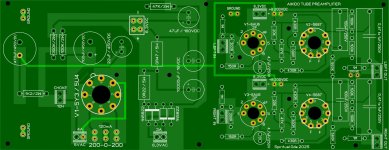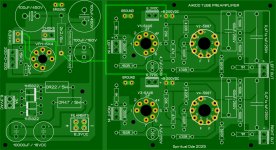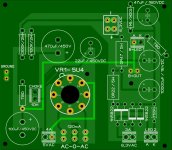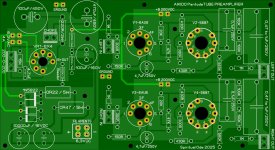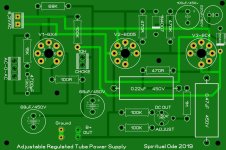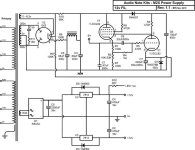@metanastis Looking good! Have you tested this out yet or still in the designing stage? I'm looking for an all in one using octal base. I'm thinking of designing one but having started yet. 🙂
@tommuel123
I have designed and constructed 7 tube preamplifiers so far. They are mostly created from the original schematics of brands like Audio Note, Marantz, Cary and Audio Research.Last night I designed the Noval version of the Aikido. I use the sprint layout 6. I can design the Octal version with 5U4 or 6X4 and a 6,3 volts power supply, all in one.
I have never used a 6AU6 or 5687 in any of my designs and I was very curious to test that configuration as I have many tubes like that in my stock( I have many 6SN7s too).
Unfortunately, I don't have the LT spice and I can't use it for the circuit evaluation. Sometimes I use NI Simulator 12 but I don't think it contains tubes like 6AU6 and 5687. I have recently constructed the Peter Millet low mu preamplifier with 6080 and EL34 and it sounds great.
Have a nice day.
Spiros
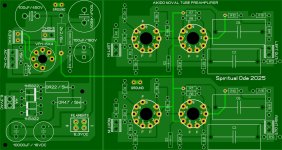
Last edited:
@metanastis Here is a simulation in LTSpice. As usual, simulation caveats: ideal power supplies, perfectly matched tubes, proper models etc.

Gain 35

Gain 35
Attachments
@jcalvarez
Thank you very much for your great effort. It looks really good. I think I will design all of Aikido's versions( Noval and Octal plus the pentode one) and send them to China for production.I have many NOS American tubes and I want to test out all the versions.
Just another critical question.@metanastis Here is a simulation in LTSpice. As usual, simulation caveats: ideal power supplies, perfectly matched tubes, proper models etc.
View attachment 1435375
Gain 35
View attachment 1435376
Has LT spice any reference to the milliamperes consumption of the circuit? It will be needed to choose the appropriate power supply with PSU designer II. I have checked the tube data but I am not sure about the total current.
Thanks a lot.
Yes, it does, monitoring current in V1 shows the power consumption, for one channel. The simulations shows ~17mA, so probably 25mA/channel should be fine, but, again, this is for the tubes use in the simulation. Also you need to take into account the heater consumption, just from the tube datasheets.
There is a pretty good power supply simulator, PSUD2, very popular.
There is a pretty good power supply simulator, PSUD2, very popular.
You are welcome!
To be honest, a 5U4GB is really an overkill for a pre-amp power supply. You also need an extra 5V 3A winding on the power transformer. I'd go solid state, or something based on a 6X4 if you are set on tubes for the rectifier.
To be honest, a 5U4GB is really an overkill for a pre-amp power supply. You also need an extra 5V 3A winding on the power transformer. I'd go solid state, or something based on a 6X4 if you are set on tubes for the rectifier.
I have many NOS tubes in stock, so there is no second thought for SS power supply.
Yes, 5U4 demands the 5V heater voltage and I can surely try 6X4 or 6CA4 instead.
I prefer the all-tube design because I am a tubeman😊
Yes, 5U4 demands the 5V heater voltage and I can surely try 6X4 or 6CA4 instead.
I prefer the all-tube design because I am a tubeman😊
Understood. A 6X4 would be a pretty good match, max 70mA of rectified DC. I'd also recommend a choke instead of a resistor to keep the hum down.
Do you know the choke's DCR? I just want to simulate the power supply.
PS also the primary and secondary DCR for the power transformer.
PS also the primary and secondary DCR for the power transformer.
Last edited:
You already used PSD2, nothing for me to add 🙂My military choke is DCR=110R. I placed that value in PSUD II.
As I have noticed using the PSUD II, the secondary DCR varies the output voltage by a couple of volts. The most crucial parameter is the load current. The program default value is 31 Ohms for the CT secondary of the transformer. I changed that value to 100 ohms and noticed a 6-volt difference which is OK for a tube PS.
Yes. DCR is also important for the rectifier tube, but in your case you have a 220 ohm resistor before the first cap, which softens the blow.
The resistor allows you to add a larger capacitor after the tube and reduces the DC voltage to the proper level.
Audio Note uses a choke after the rectifying tube in some models. IMO the power supply is the heart of any electronic design and we must pay a lot of attention to a design that covers all of our device specifications.
Audio Note uses a choke after the rectifying tube in some models. IMO the power supply is the heart of any electronic design and we must pay a lot of attention to a design that covers all of our device specifications.
- Home
- Amplifiers
- Tubes / Valves
- Aikido Noval PCB (or Gerber) Source
